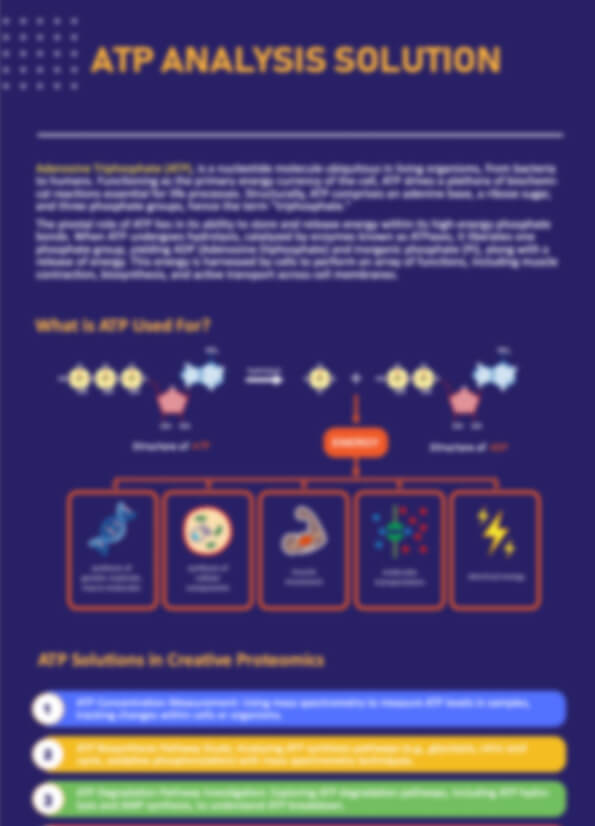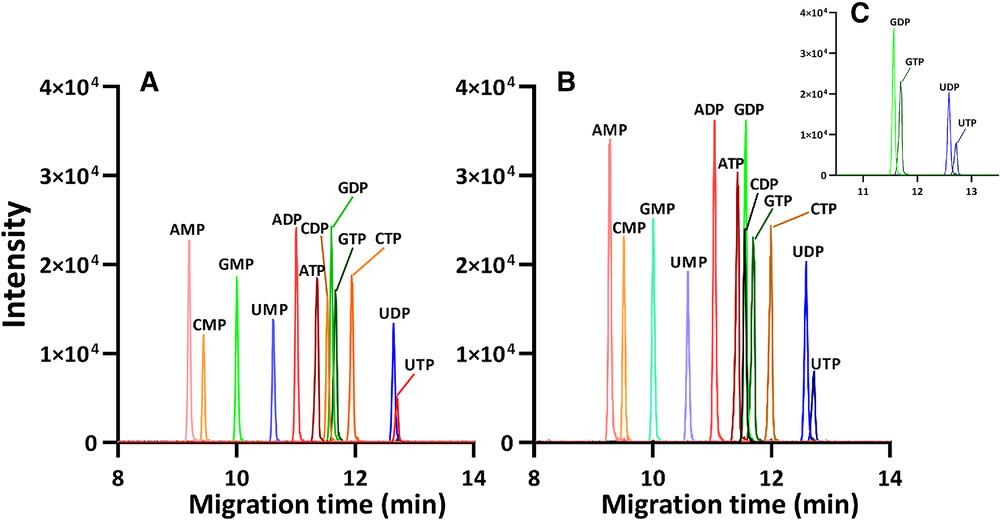Adenosine Triphosphate Analysis Service
Creative Proteomics specializes in offering comprehensive adenosine triphosphate (ATP) analysis services, including precise quantification, qualitative profiling, and in-depth metabolite detection. Our advanced analytical platforms, such as HPLC, mass spectrometry, and bioluminescent assays, ensure high sensitivity and accuracy for ATP and related metabolite evaluation. We also provide pathway analysis to uncover metabolic disruptions and energy dynamics, supporting research in energy metabolism, disease mechanisms, and therapeutic development.
Submit Your Request Now
×- Define
- What We Provide
- List of ATP Metabolites
- Technology Platform
- Advantages
- Sample Requirements
- Applications
- Demo
- FAQs
- Case
- Publications
What is Adenosine Triphosphate?
Adenosine Triphosphate (ATP) is a nucleotide that plays a central role in cellular energy transfer. It consists of adenine (a nitrogenous base), ribose (a five-carbon sugar), and three phosphate groups. The high-energy bonds between the phosphate groups make ATP a vital energy carrier in all living organisms. When one of these phosphate groups is cleaved through hydrolysis, ATP is converted into ADP (Adenosine Diphosphate), releasing energy that is used in numerous biological processes.
ATP is often referred to as the "molecular unit of currency" for intracellular energy transfer. This energy is crucial for various cellular functions, including protein synthesis, muscle contraction, cell division, and active transport across cell membranes. ATP is continuously regenerated through processes like cellular respiration and photosynthesis to ensure an uninterrupted energy supply for cellular activities.
ATP Metabolism
ATP metabolism involves the processes by which ATP is synthesized, utilized, and recycled in cells. The primary pathways for ATP production include:
- Glycolysis: A process occurring in the cytoplasm, where glucose is broken down into pyruvate, producing ATP in the process. Glycolysis is an anaerobic pathway, meaning it does not require oxygen.
- Oxidative Phosphorylation (Electron Transport Chain and Chemiosmosis): This occurs in the mitochondria and is the main source of ATP production in cells. The electron transport chain generates a proton gradient across the inner mitochondrial membrane, which drives the synthesis of ATP via the enzyme ATP synthase.
- Citric Acid Cycle (Krebs Cycle): This cycle, also in the mitochondria, oxidizes acetyl-CoA derived from carbohydrates, fats, and proteins, and produces high-energy electron carriers that feed into the electron transport chain to produce ATP.
- Phosphocreatine System: In muscle cells, the phosphocreatine system is a rapid source of ATP during short bursts of intense activity. Phosphocreatine donates its phosphate group to ADP to regenerate ATP quickly.
ATP is continuously consumed during cellular processes, and its production is tightly regulated to meet the energy demands of the cell. When ATP levels are low, various signaling pathways activate mechanisms to increase its production, while maintaining a balance to avoid excessive ATP accumulation, which could disrupt cellular processes.
 (Jing Tao et al,. Food Bioscience 2023)
(Jing Tao et al,. Food Bioscience 2023)
Adenosine Triphosphate Analysis Offered by Creative Proteomics
Quantitative ATP Measurement
Using high-sensitivity techniques, we accurately quantify ATP levels across various biological samples. This allows for precise assessment of cellular energy status and metabolic shifts in response to experimental conditions, disease states, or therapeutic interventions.
Qualitative ATP Profiling
Our qualitative ATP profiling identifies fluctuations in ATP concentrations across different conditions or cell types. This approach provides insights into cellular energy balance, metabolic disorders, and energy consumption patterns.
ATP Metabolite Analysis
In addition to ATP, we analyze a range of metabolites directly involved in ATP synthesis, regulation, and consumption.
ATP-Related Pathway Analysis
We offer pathway analysis services to investigate metabolic pathways directly influencing ATP production and utilization, such as glycolysis, oxidative phosphorylation, and the citric acid cycle. This service helps identify potential metabolic disruptions and evaluate energy production efficiency.
List of Adenosine Triphosphate Metabolites We Can Analyze
| Metabolite Name | ||||
|---|---|---|---|---|
| Adenosine Triphosphate (ATP) | Adenosine Diphosphate (ADP) | Adenosine Monophosphate (AMP) | Adenosine | Inorganic Phosphate (Pi) |
| Creatine Phosphate (CP) | Phosphocreatine (PCr) | Nicotinamide Adenine Dinucleotide (NAD+) | Nicotinamide Adenine Dinucleotide (NADH) | Flavin Adenine Dinucleotide (FAD) |
| Flavin Mononucleotide (FMN) | Guanosine Triphosphate (GTP) | Guanosine Diphosphate (GDP) | Guanosine Monophosphate (GMP) | Cytidine Triphosphate (CTP) |
| Cytidine Diphosphate (CDP) | Cytidine Monophosphate (CMP) | Uridine Triphosphate (UTP) | Uridine Diphosphate (UDP) | Uridine Monophosphate (UMP) |
| S-Adenosylmethionine (SAM) | S-Adenosylhomocysteine (SAH) | Nicotinamide Mononucleotide (NMN) | Cyclic Adenosine Monophosphate (cAMP) | Cyclic Guanosine Monophosphate (cGMP) |
| Pyrophosphate (PPi) | Adenosine Tetraphosphate (Ap4) | NADP+ | NADPH | Coenzyme A (CoA) |
| Acetyl-CoA | Succinate | Malate | Fumarate | Citrate |
| Isocitrate | α-Ketoglutarate | Oxaloacetate | 3-Phosphoglycerate (3-PG) | 2-Phosphoglycerate (2-PG) |
| Phosphoenolpyruvate (PEP) | Lactate | Pyruvate | ||
Technology Platforms for Adenosine Triphosphate Analysis
High-Performance Liquid Chromatography (HPLC)
- Agilent 1290 Infinity II LC System: Equipped with high-resolution capabilities for separating ATP and related nucleotides in complex biological matrices.
- HPLC coupled with UV detection: Accurate quantification of ATP through absorption at specific wavelengths.
Mass Spectrometry (MS)
- Thermo Scientific Q Exactive Orbitrap Mass Spectrometer: High-resolution MS for precise ATP quantification with minimal interference.
- Triple Quadrupole Mass Spectrometer (Agilent 6470): Highly sensitive MS for ATP analysis in complex matrices with exceptional accuracy.
Luciferase-based ATP Assay
Bioluminescent detection: A highly sensitive assay using luciferase enzyme, which catalyzes the conversion of ATP to light. The emitted light is proportional to ATP concentration, providing an easy-to-use and accurate method for ATP quantification.
Fluorescent-Based ATP Detection
ATP binding to specific fluorescent probes leads to measurable fluorescence changes, allowing quantification with high sensitivity in live-cell applications.

Agilent 1290 Infinity II LC System (Figure from Agilent)

Q Exactive™ Plus Hybrid Quadrupole-Orbitrap™ Mass Spectrometer (Figure from Thermo Scientific)
Advantages of Adenosine Triphosphate Assay
- High Sensitivity and Precision: Detect ATP and related metabolites at femtomolar levels, ensuring reliable data from trace amounts.
- Comprehensive Metabolic Coverage: Analyze over 50 ATP-related metabolites, including intermediates in energy pathways like glycolysis, TCA cycle, and oxidative phosphorylation.
- Advanced Instrumentation: State-of-the-art LC-MS/MS platforms ensure high-resolution separation and accurate quantification.
- Dynamic Quantification Range: Covers up to five orders of magnitude, suitable for diverse biological samples and applications.
- Customized Data Analysis: Offers pathway mapping and metabolic flux analysis to provide actionable insights for energy metabolism research.
- Wide Sample Compatibility: Compatible with plasma, tissues, cells, and purified extracts, supporting diverse experimental needs.
- Fast Turnaround Time: Streamlined workflows ensure rapid data delivery without compromising quality.
- High Reproducibility: Coefficient of variation (CV) below 5% for consistent and reliable results across replicates.
Sample Requirements for Adenosine Triphosphate Analysis
| Sample Type | Recommended sample size | Pre-treatment and storage |
|---|---|---|
| Tissue | 100-200mg | Snap freezing in liquid nitrogen, stored at -80°C. |
| Urine | 0.2-0.5ml | 5000×g 4°C Centrifuge for 30-60min, remove supernatant, store at -80°C. |
| Serum/plasma | >0.1ml | Collected serum/plasma, snap freezing in liquid nitrogen, stored at -80°C. |
| Cerebrospinal fluid, amniotic fluid, bile and other body fluids | >0.2ml | 4°C Centrifuge for 10min, (or filter using 0.22μm membrane), remove supernatant and store at -80°C. |
| Suspension cells | >107 | Centrifuge and collect cells after liquid nitrogen snap freezing and store at -80°C. |
| Walled cells | >107 | Cultured walled cells are stored in 1.5ml centrifuge tubes, snap freezing in liquid nitrogen and stored at -80°C |
| Cell supernatant | >2ml | centrifuge at 4℃ for 3 minutes, take the supernatant and store at -80℃. |
Applications of Adenosine Triphosphate Assay Service
- Biomedical Research: Examine cellular energy metabolism and ATP-related disorders.
- Pharmacology: Evaluate drug-induced changes in ATP levels and metabolic pathways.
- Cancer Research: Investigate altered ATP metabolism in tumor progression and therapeutic responses.
- Neuroscience: Study ATP roles in neural signaling, synaptic function, and neurodegenerative diseases.
- Toxicology: Detect ATP depletion as a marker for cellular stress or toxicity.
- Metabolomics: Analyze ATP and its related metabolites to uncover metabolic adaptations.
- Biotechnology: Optimize bioprocesses by monitoring ATP in cell cultures.
- Sports Science: Research ATP dynamics in muscle function and athletic performance.
- Infectious Diseases: Explore host-pathogen interactions by measuring ATP variations.
- Agricultural Science: Study plant energy metabolism and stress adaptation mechanisms.
Demo

Representative overlaid HPLC chromatograms of calibration standard (X), BEAS-2B cells sample, differentiated NHBE cells sample. (Juarez-Facio, et al., Molecules, 2021).
FAQ of Adenosine Triphosphate Analysis
How do sample preparation and handling affect ATP quantification?
Sample preparation is critical for accurate ATP quantification. Factors such as the choice of extraction method (e.g., solid-phase extraction) and maintaining sample integrity during processing can significantly impact results. For instance, using duplicate samples can reduce variability in measurements, ensuring more reliable data2. Additionally, ATP levels can degrade rapidly; therefore, samples should be processed promptly or stored under appropriate conditions to minimize degradation.
Can you analyze ATP in live cells or in vivo samples?
Yes, we offer ATP analysis in live cells and in vivo samples using our sensitive luciferase-based ATP assay. This approach allows us to measure ATP levels in real-time and in situ, providing insights into cellular energy status under dynamic conditions.
Can ATP analysis help with studying metabolic diseases?
Absolutely. ATP analysis can provide valuable insights into energy metabolism, making it a key tool for studying diseases like cancer, diabetes, cardiovascular conditions, and neurological disorders. Altered ATP levels can be indicative of disruptions in metabolic pathways, which can help identify potential biomarkers or therapeutic targets.
Learn about other Q&A.
Adenosine Triphosphate Analysis Case Study
Publications
Here are some publications in Metabolomics research from our clients:

- The activity of the aryl hydrocarbon receptor in T cells tunes the gut microenvironment to sustain autoimmunity and neuroinflammation. 2023. https://doi.org/10.1371/journal.pbio.3002000
- Resting natural killer cell homeostasis relies on tryptophan/NAD+ metabolism and HIF‐1α. 2023. https://doi.org/10.15252/embr.202256156
- Neddylation is required for perinatal cardiac development through stimulation of metabolic maturation. 2023. https://doi.org/10.1016/j.celrep.2023.112018
- UDP-Glucose/P2Y14 Receptor Signaling Exacerbates Neuronal Apoptosis After Subarachnoid Hemorrhage in Rats. 2024. https://doi.org/10.1161/STROKEAHA.123.044422
- High Levels of Oxidative Stress Early after HSCT Are Associated with Later Adverse Outcomes. 2024. https://doi.org/10.1016/j.jtct.2023.12.096









